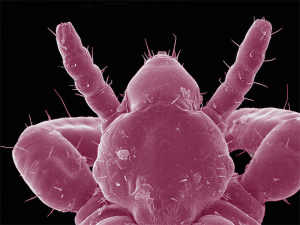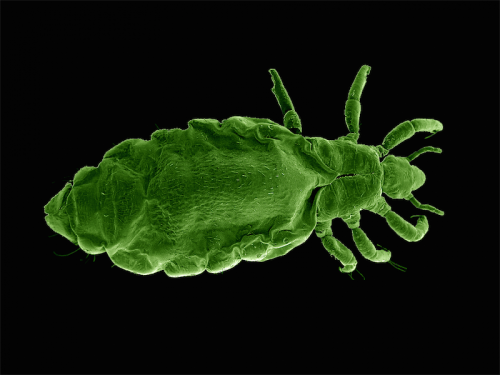
This blue-faced louse (Campanulotes bidentatus) was found on a pigeon. The soft downy feathers of the pigeon provide a warm place for the lice to live and are also their source of food. Can you see the “two teeth” or mandibles these lice use to eat with? Image courtesy of Cath Covacin, Stephen Barker and Rick Webb, University of Queensland.
The society says parasites are normally thought of as disgusting and regarded as an aberration but, in fact, the parasitic way of life is the most common way of life on the planet.
They are the most ingenious and manipulative of all life forms and possess a strange beauty, as these photos, taken by scientists who study parasites, show.
They are a part of everyone’s life – they infect our pets, the meat and crops we eat, and us.
They also infect our marsupial wildlife and the fish in our oceans and reefs, sometimes with devastating consequences.

Pediculus capitas (in pink) are parasitic lice that are often found in our hair. They live, eat blood, sleep, and lay their eggs close to our scalp so the heat from our head allows the egg to hatch in about a week. They live for just over a month. Image courtesy of Cath Covacin, Stephen Barker and Rick Webb, University of Queensland.
Parasites are usually defined as organisms that live in or on another organism (the hosts) and often causes them harm.
Well-known examples of parasites include tapeworms, roundworms, ticks and fleas. Human diseases such as malaria, bilharzia, elephantiasis and sleeping sickness are all caused by parasites.
By understanding the ways of parasites, scientists can find new ways to control malaria, human hookworms, schistosomes, and veterinary parasites. If they are successful, the lives of millions of people will be saved, their crops and livestock will be more productive and the impact on reducing poverty in the Third World will be immense.
To get up close and personal with parasites, the CSIRO Discovery Centre, North Science Road, Acton, is exhibiting “Parasites in Focus”, weekdays, until August 1. Entry is free.
PARASITES have been affecting soldiers for centuries in times of war and peace and ANU scientist Dr Rowena Martin will describe some of the devastating effects caused by the malaria parasite with an address titled “Malaria in Wartime” at the Australian War Memorial Lecture Theatre, from 2pm on Sunday, August 17.
And look out for more parasites during National Science Week at “Science in ACTion”, which will run from August 15-17 at the Melville Hall, ANU.
More information at parasite.org.au/

Like fleas, lice live on, not in, their hosts and feed on blood in order to survive and make their eggs. This is a Pediculus humanis capitus or head louse. Image courtesy of Cath Covacin, Stephen Barker and Rick Webb, University of Queensland.
The post Strange beauty of the killer parasites appeared first on Canberra CityNews.